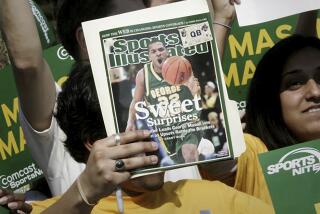Too much stock in bad info
- Share via
JUST AS every corner of the connected world benefits from the Web’s power to eliminate time and distance as obstacles to spread information, no place is safe from its equal and opposite power to spread misinformation. Wall Street, perhaps more than any other industrial nerve center, sits astride this fault line. The financial sector has an endless thirst for hypercurrent news, but it also gulps down plenty of impurities.
There was the case last month of the 6-year-old Chicago Tribune news article announcing United Airlines’ bankruptcy on the South Florida Sun Sentinel’s website (the two papers, like the Los Angeles Times, are owned by Tribune Co). By way of various computer gaffes at Tribune and Google News, plus a dollop of human error, the archived story was mistaken for a breaking development and was picked up by Bloomberg’s financial news service, where it immediately triggered a panicked sell-off that hacked 70% off United’s stock price in a matter of 10 minutes. The Nasdaq had to halt trading on the stock for more than an hour while investors figured out what had gone wrong.
Then last week, an anonymous user of CNN’s ireport.com -- a loosely moderated site where users can submit homegrown news -- posted a report that Apple Inc.’s chief executive, Steve Jobs, had suffered a massive heart attack. The report was picked up by the popular technology blog Silicon Alley Insider, which contacted Apple for confirmation but not before posting the rumor, describing it as “a story of major consequence” that “no one else has reported.”
When Apple got back to Silicon Alley Insider, the company denied the rumor, and CNN removed it, calling it “fraudulent.” Still, in the story’s half-hour life span, Apple shares fell more than 5% before partially rebounding. Securities and Exchange Commission investigators are reportedly looking into whether the rumor was started by someone trying to manipulate the stock.
Both stories underwent a now familiar alchemy, whereby junky Web rumors gain credibility the moment they’re touched by a source that someone’s heard of.
Sometimes the story passes through so many hands that assigning blame becomes academic. Was it Tribune’s fault for letting an old story appear to be new or Google’s fault for not knowing the difference, or was it the fault of the guy who believed Google when it offered a new-looking story or Bloomberg’s fault for not vetting its contributors well enough? And what about the traders? Can’t these highly paid professionals get someone to spend 10 minutes verifying these catastrophes?
Not so fast. Or rather, not so slow. “These things happen very, very quickly,” said economist Robert Aliber of the University of Chicago. “The people who are closely involved probably don’t have the time to do the checking. It’s more important for them to be on the right side of the trade than to be library-type researchers.”
You wouldn’t get much further pinning the Jobs rumor on CNN, or Silicon Alley Insider, or even the hoaxer who posted the false report.
And, as Silicon Alley Insider Editor Henry Blodget pointed out, the crisis came and went in a flash. “The Web can certainly spread misinformation fast, but it’s equally capable of spreading correct information fast. With the Steve Jobs heart attack story last week, the market had the rumor and the answer within half an hour -- and both were accessible to everyone.”
But rumors by their nature are destabilizing.
Robert Bruner, dean of the University of Virginia Darden School of Business and author of “The Panic of 1907,” said that at the center of every market scare, micro or macro, is a kind of disorientation that comes when some people know what’s going on and others don’t.
“Somebody asked me, ‘So how is today’s crisis different from the great crash of 1929?’ And the answer is the speed, complexity and sheer scale” of the market system.
It’s no coincidence that the same phrase describes the Web’s central information problem as well. There are so many parties both producing and consuming information that it’s impossible for everyone to be on the same page.
Just go to any trading floor, Bruner said. Besides the banks of TV screens and news feeds on the walls, “the traders have their own news sources, scanning the Internet, reading the blogs and chatter, looking to exploit the arrival of news advantageously.”
Wall Street, in other words, has the Internet pumped directly into its brain. Just so, the two share the same exhilarating, maddening personality.
--
More to Read
Inside the business of entertainment
The Wide Shot brings you news, analysis and insights on everything from streaming wars to production — and what it all means for the future.
You may occasionally receive promotional content from the Los Angeles Times.










